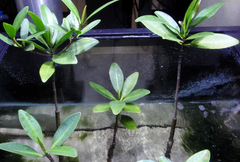How to Lower Nitrates in your Saltwater or Reef Aquarium
Nitrates are the end result of the nitrogen cycle in marine and reef aquariums. High nitrate levels can be harmful to fish and lethal to corals, which are sensitive to nitrates, and can trigger undesirable algae blooms. The best way to remove nitrates from your saltwater or reef aquarium is by doing partial water changes on a regular basis. However some reef keepers with large tanks find this to be time consuming and costly to continually replace salt water. In an effort to reduce the frequency of water changes a number of techniques can be employed to help reduce nitrates or even bring them down to zero! Learn how to reduce nitrates in a saltwater or live coral reef aquarium.
 The first thing you will need in your battle against aquarium nitrates is a good nitrate test kit. Be sure to select one that is intended for saltwater use, and that the reagents are not expired. Once you have a nitrate test kit, you can perform a test on a water sample from your aquarium to determine how high the nitrates are. Write it down in a log book or enter the value in an aquarium water parameter tracking app for your smartphone. You will want to reference this data as you treat the nitrates so you can track your progress.
The first thing you will need in your battle against aquarium nitrates is a good nitrate test kit. Be sure to select one that is intended for saltwater use, and that the reagents are not expired. Once you have a nitrate test kit, you can perform a test on a water sample from your aquarium to determine how high the nitrates are. Write it down in a log book or enter the value in an aquarium water parameter tracking app for your smartphone. You will want to reference this data as you treat the nitrates so you can track your progress.
 Once you know what your nitrate levels are, if they are dangerously high, you need to get them down quickly and gradually. There are a variety of natural, liquid bacterioplankton products available that will help bring nitrates down quickly over a short period of time such as Brightwell Reef Bio Fuel and Red Sea NO3 PO4-X. Both products treat nitrates and phosphates. Be sure to read the manufacturer's instructions and follow the dosing instructions carefully. In the event of a lethal nitrate level, it is advised that you perform an emergency water change of at least 25% to help get the nitrates down to a non-lethal level immediately.
Once you know what your nitrate levels are, if they are dangerously high, you need to get them down quickly and gradually. There are a variety of natural, liquid bacterioplankton products available that will help bring nitrates down quickly over a short period of time such as Brightwell Reef Bio Fuel and Red Sea NO3 PO4-X. Both products treat nitrates and phosphates. Be sure to read the manufacturer's instructions and follow the dosing instructions carefully. In the event of a lethal nitrate level, it is advised that you perform an emergency water change of at least 25% to help get the nitrates down to a non-lethal level immediately.
 Once you have the nitrates down to an acceptable level, or even zero in the case of a reef tank, you will want to keep the nitrates low. To do this you can use a re-chargeable de-nitrification media in a media reactor, canister filter, or even in a flow through mesh bag in a high water volume area of the tank such as an over flow or a sump. There are also a number of synthetic polymers available that help remove nitrates, nitrites and ammonia such as Seachem Purigen.
Once you have the nitrates down to an acceptable level, or even zero in the case of a reef tank, you will want to keep the nitrates low. To do this you can use a re-chargeable de-nitrification media in a media reactor, canister filter, or even in a flow through mesh bag in a high water volume area of the tank such as an over flow or a sump. There are also a number of synthetic polymers available that help remove nitrates, nitrites and ammonia such as Seachem Purigen.
 If you have a refugium, you may opt for a natural solution to nitrate reduction and try some planted marine algae or even a mangrove plant or two. Certain marine plants and alga feed on nitrates and will thrive in a refugium if given proper conditions. If you do not have a refugium, you can also try using certain corals to control nitrates such as Xenia.
If you have a refugium, you may opt for a natural solution to nitrate reduction and try some planted marine algae or even a mangrove plant or two. Certain marine plants and alga feed on nitrates and will thrive in a refugium if given proper conditions. If you do not have a refugium, you can also try using certain corals to control nitrates such as Xenia.
 Getting your nitrate levels down and keeping them down doesn't have to be controlled by doing frequent and sometimes expensive water changes. With a little persistence, you can keep your nitrates at zero, and keep your fish and corals very happy and healthy!
Getting your nitrate levels down and keeping them down doesn't have to be controlled by doing frequent and sometimes expensive water changes. With a little persistence, you can keep your nitrates at zero, and keep your fish and corals very happy and healthy!
